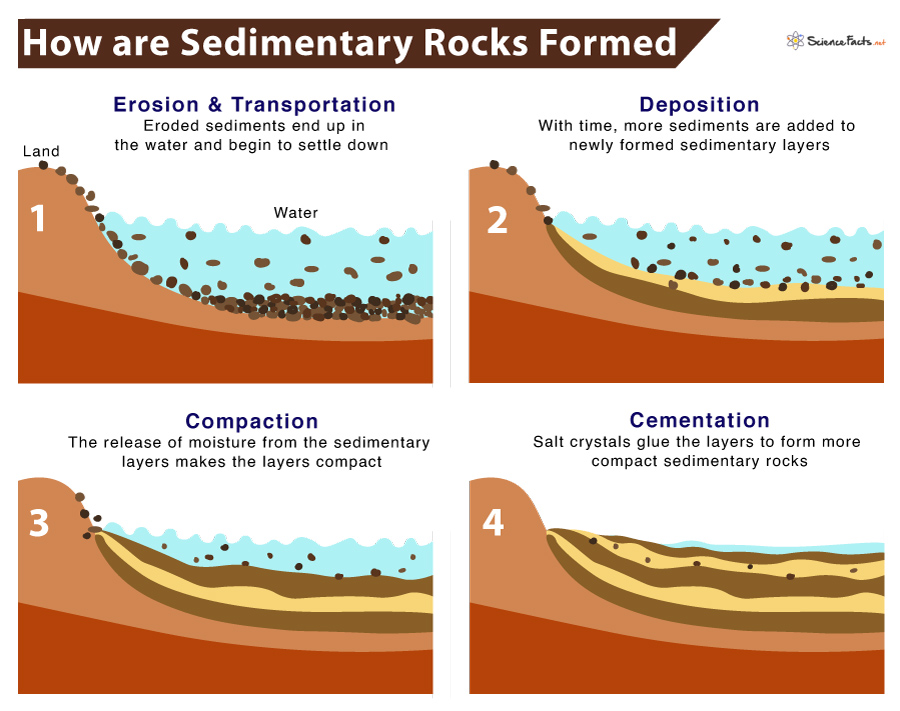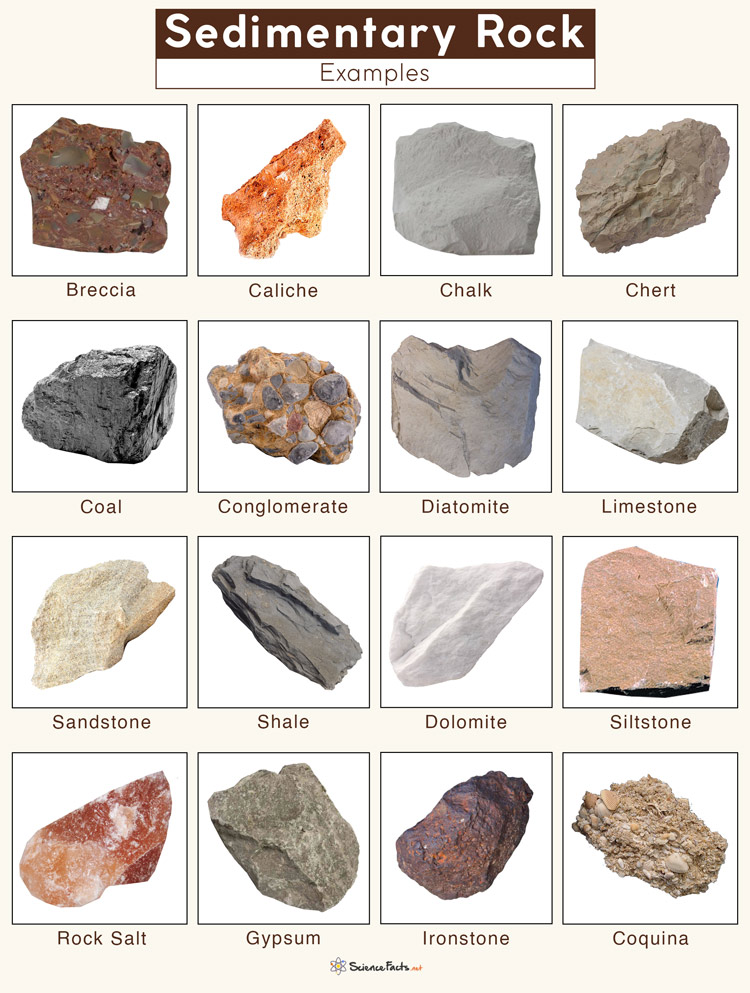What are Sedimentary Rocks Made of
Where are they Found
How are Sedimentary Rocks Formed
Types
Sedimentary Rocks Examples
What are the Uses of Sedimentary Rock and Why are they Important
Fun Facts for Kids
- Weathering: Involves breaking of more giant rocks into smaller ones due to wind and water. Weathering can transform boulders and even mountains into sediments such as sand and mud. Dissolution is a chemical weathering process where partially acidic water wears away solid rocks.
- Erosion: The weathered materials are worn away and transported by natural forces such as wind, water, ice, or gravity. Erosion starts the transportation process.
- Transportation: The actual movement of eroded materials from their original position to different places. Transportation occurs due to natural forces such as wind, water, ice, or gravity.
- Deposition: Next, the sediments, soil, or rocks are added to the preexisting landform or landmass. Deposition occurs when the energy of the transportation medium becomes too low to transport sediment.
- Precipitation: The deposited sediments then form rocks and minerals from chemicals that precipitate from water. As the water dries up, it leaves behind mineral deposits.
- Lithification (Diagenesis): Clay, sand, and other sediments on the bottom of the water bodies become sedimentary rock when slowly compacted into rocks from the weight of overlying sediments. Lithification releases moisture, thus reducing the pore space of the sediments, making the sedimentary rock compact. This process is also called compaction.
- Cementation: Finally, salt crystals glue the layers together to form a compact sedimentary rock.
1. Clastic Sedimentary Rocks
They are also called detrital sedimentary rocks and are formed from pieces of preexisting rocks loosed by weathering. The loosened rocks are then transported to some depression where the sediments are trapped. If it is buried deep, it becomes compacted and cemented, forming sedimentary rock. Clastic sedimentary rock may have particles ranging in size from microscopic size to huge boulders. Their names are determined based on the clast and the grain size. Some common examples are clay, silt, and sand. A grain size larger than 2 millimeters is called pebble. Clastic sedimentary rocks are classified according to the characteristics of clasts (rock and mineral fragments) that comprise them. These properties are grain size, grain shape, and fabric (grain packing and orientation). Apart from this type of sedimentary rock, the other two types are called non-clastic sedimentary rocks. Clastic sedimentary rock is found in:
Arches National Park, UtahGrand Canyon National Park, Arizona
2. Biological Sedimentary Rocks
They are also called bioclastic, biochemical, or organic sedimentary rocks. Biological sedimentary rocks are formed when living organisms die, pile up, and compress and cement together. Thus most fossils are found in these types of rocks. Some common examples of biological sedimentary rock are coal (plant remains) and limestone (remains of marine organisms). Biologic Sedimentary Rock is found in:
Biscayne Bay National Park, FloridaGuadalupe Mountains National Park, Texas
3. Chemical Sedimentary Rocks
They form by precipitation when water traveling through rocks dissolves some of the minerals. The dissolved minerals are then transported away from their source and finally redeposited or precipitated when the water evaporates away. When evaporation occurs, crystallite rocks may form. Chemical sedimentary rocks are found in many places, from the ocean to the desert to caves. Stalactites and stalagmites form when water passes through bedrock, where it meets calcium and carbonate ions. When the chemical-rich water enters a cave, the water evaporates and leaves behind calcium carbonate on the ceiling, forming a stalactite or on the floors, creating a stalagmite. Chemical Sedimentary Rock is found in:
Oregon Caves National Monument, OregonCarlsbad Caverns National Park, New MexicoWhite Sands National Monument, New Mexico
Breccia: A clastic sedimentary rock composed of large angular fragments. The spaces between the large particles are filled with smaller particles or mineral cement that help to bind the rock together. Caliche: A clastic sedimentary rock composed of rounded rock fragments and fine-grained sediments compiled together with calcium carbonate cement. Chalk: A type of limestone made up of tiny calcium carbonate shells of marine organisms. Chalk is soft, friable, and porous. It serves as a reservoir of fuels such as oil and natural gas. Chert: Usually an organic rock but can also occur inorganically. Chert is hard, fine-grained, and is composed of silicon dioxide (SiO2) or quartz that is microcrystalline or cryptocrystalline. Coal: Organic sedimentary rock made from plant debris. All coal types apart from anthracite are sedimentary rocks. Conglomerate: A clastic sedimentary rock containing large rounded particles. The spaces between the large particles are filled with smaller particles that help to bind the rock together. Diatomite: It is also known as dolostone. Dolomite is a biological sedimentary rock made up of skeletal remains of Diatoms, a type of tiny single-celled algae. It is lightweight, porous, relatively inert, and small particle size with a large surface area. Coquina: Limestone composed of calcium carbonate shells, shell fragments, and other sand-sized fossil debris. Limestone: It can be a biological or crystalline chemical sedimentary rock composed primarily of calcium carbonate. It can organically form from the accumulation of shell, coral, algal, and fecal debris. It can also form chemically through the precipitation of calcium carbonate from lake or ocean water. Limestone is the most abundant chemical sedimentary rock found on Earth. Sandstone: A clastic sedimentary rock made of sand-sized, weathering debris. It is naturally found in beaches, deserts, flood plains, and deltas. Shale: A clastic sedimentary rock that is made up of clay-sized, weathering debris. Dolomite: A chemical sedimentary rock very similar to limestone. Dolomite forms when limestone or lime mud is modified by magnesium-rich groundwater. Siltstone: A clastic sedimentary rock that develops from weathering debris. Rock Salt: A chemical sedimentary rock that forms from the evaporation of ocean or any saline water bodies. Rock salt is composed entirely of halites, a mineral composed of sodium chloride, NaCl. Gypsum: A crystalline, chemical sedimentary rock found in layered sedimentary deposits in association with halite, anhydrite, sulfur, calcite, and dolomite. Ironstone: A chemical sedimentary rock that contains more than 15% iron, containing iron-bearing minerals such as goethite, siderite, and berthierine. Sedimentary rocks form porous and permeable reservoirs in sedimentary basins where water and essential minerals such as oil can be found. Materials that we use every day, such as jewelry and ceramics, are made from sedimentary rocks. They are also used in building materials.

